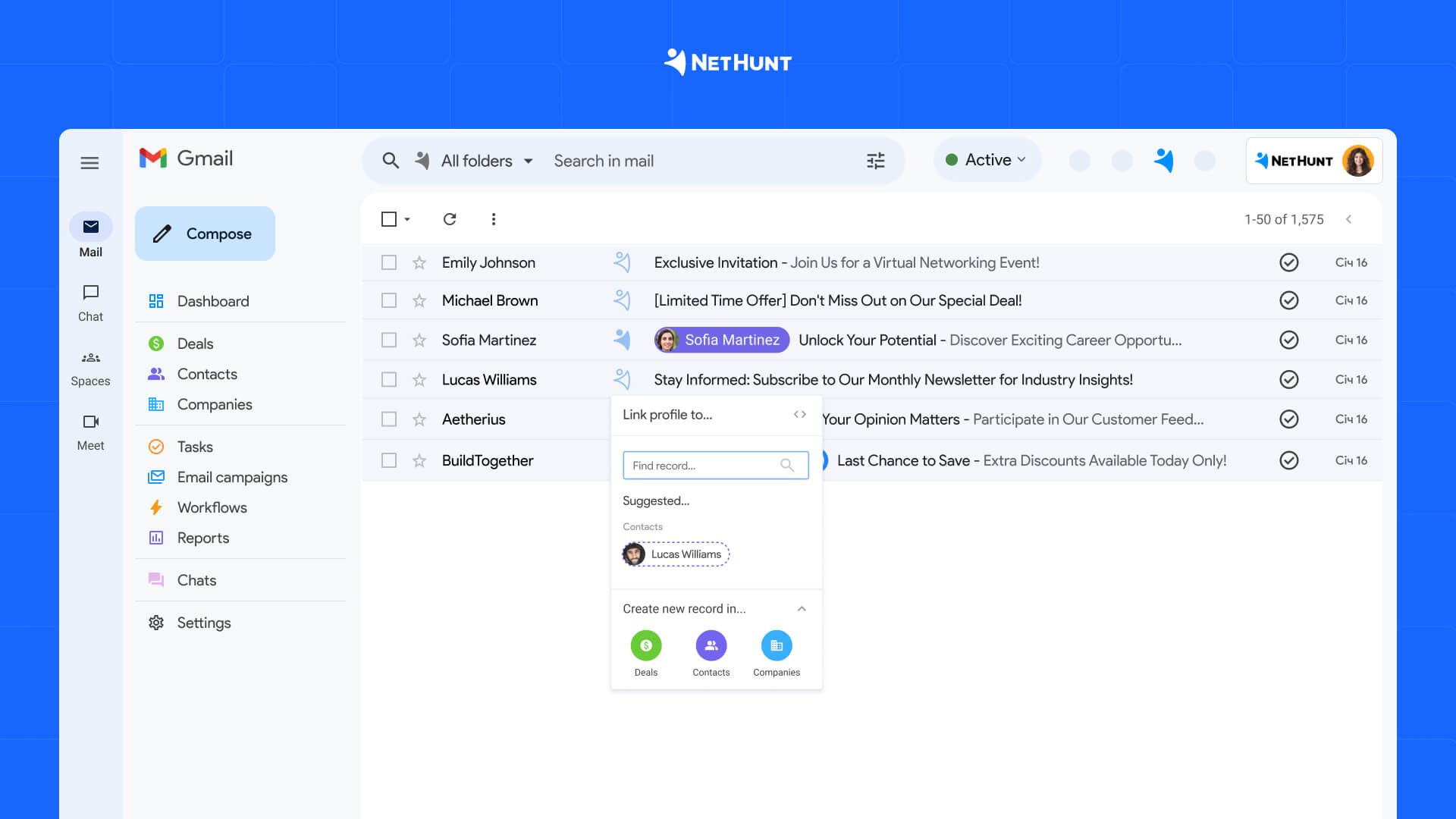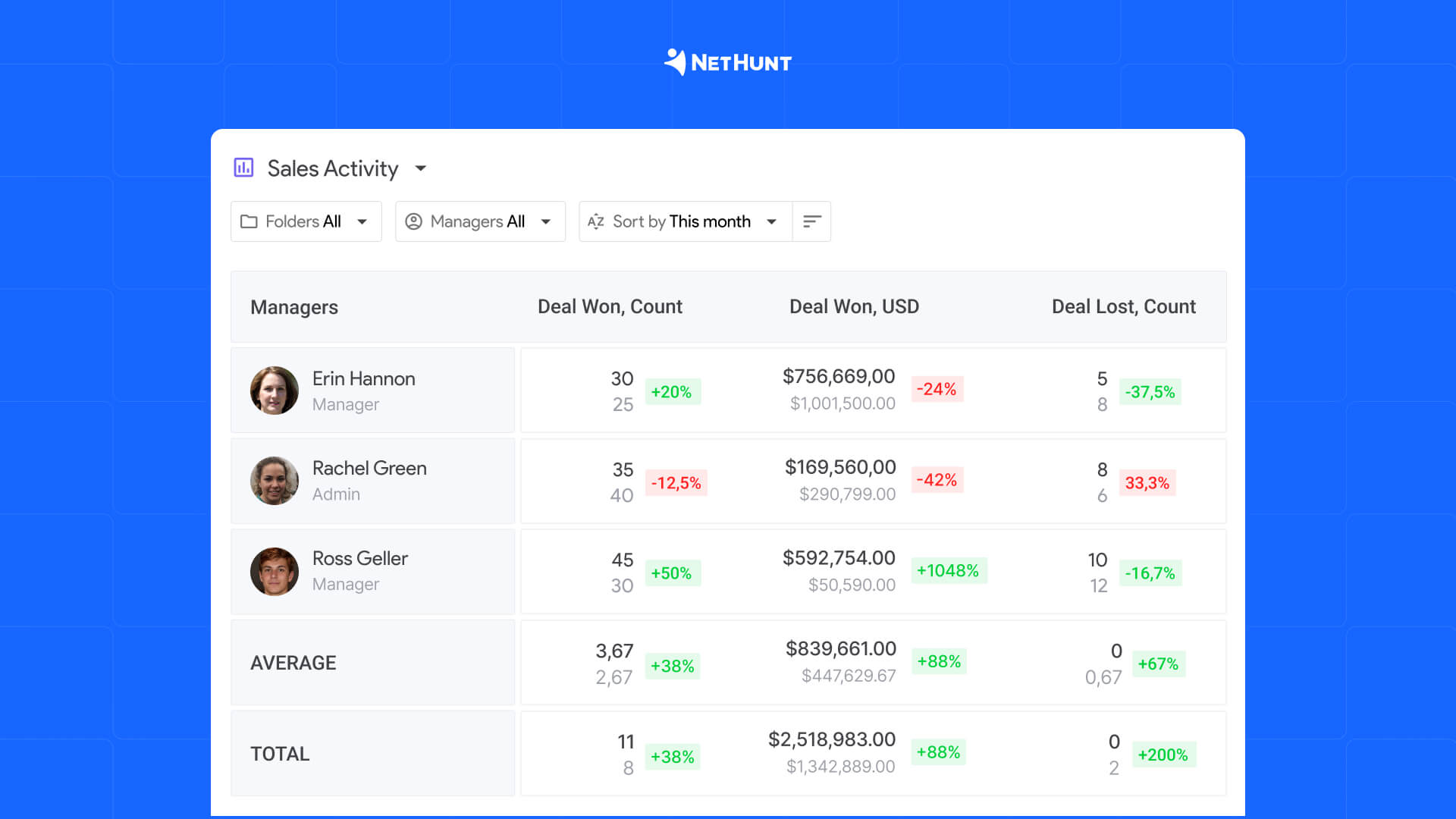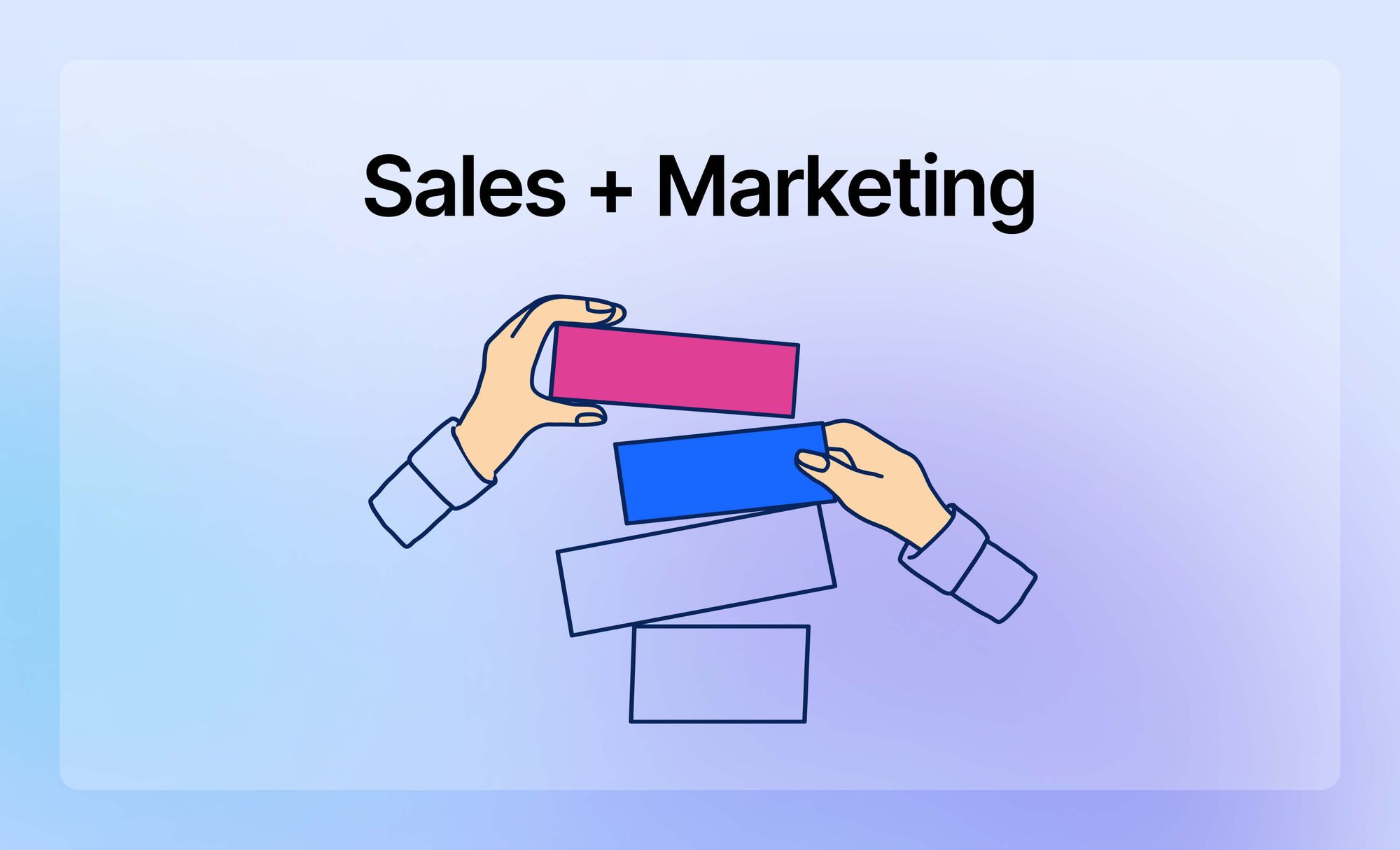Here are the secrets to sales and marketing alignment that generates revenue.
It’s the end of the quarter. You’ve invested in top-notch marketing campaigns, and your sales team has been grinding. The only question is — where is the revenue?
"You bring bad leads!" shouts Sales. "No, we bring great leads! You just don’t know how to work with them!" fires back Marketing.
Each side believes their work is more important and tends to blame the other when targets aren’t met. Can sales & marketing find common ground? The answer is yes. And here’s how ?
Step #1: Define what a ‘good’ lead looks like
The root of many sales & marketing conflicts lies in a different understanding of what qualifies as a good lead.
For sales, that might be a decision-maker with an urgent need and budget, while for marketing, it could be someone who engaged with a webinar or downloaded an eBook, but isn’t necessarily a decision-maker in a company or doesn’t showcase an urgent need to buy. In the end, you have two pretty different ICPs that confuse both teams and lead to never-ending mutual blaming.
Here is what you can do to build a strong Ideal Customer Profile (ICP):
- Analyze your existing customer database to identify patterns.
- Use web forms, surveys and gated content to collect valuable customer data in exchange for gated content or discounts. Ensure you're collecting relevant information like industry, company size, pain points, and any other details that help you qualify leads.
- Have sales share their firsthand insights about current customer challenges, objections, and success stories. This collaboration helps refine messaging and targeting with marketing.
- Interview customers with a Jobs to Be Done (JTBD) approach in mind to understand why they choose your product. Think of your product as something they "hire" to solve a specific problem. For instance, if customers use your software to automate lead management, highlight automation benefits in your marketing efforts.
With a well-defined ICP, marketing can generate high-quality leads and personalize outreach efforts, while sales can shorten the sales cycles and stop wasting time on low-quality leads.
Plus, learn the following rule: not every lead is a potential client. Define non-negotiables for the marketing team before they pass the lead to the sales department. For instance, if a lead hasn’t engaged with content or responded to outreach, it stays in marketing’s nurture campaigns until they show buying intent.
⏰ Time to practice: Schedule a monthly meeting where marketing shares audience research updates with sales. Discuss behavioral changes, purchasing decisions, and industry trends.
Keep reading to learn how CRM data helps you back up those findings.
Step #2: Align on the bigger business strategy
When sales & marketing don’t align in their actions, it’s painfully obvious to your leads and customers:
- They receive emails and calls from both sides, often irrelevant to their needs and interests
- Mixed messages about your products or services annoy them
- In the end, they think you’re unreliable and disrespectful (they even might switch to your competitor!)
We all know that good sales are a magic combination of high-quality leads from marketing plus effective lead qualification and nurturing by sales. But you can’t hit the sales target if both departments have their own understanding of what is a good lead and two different strategies.
To make things work, there should be only ONE strategy — focused on the same audience and built around clear, measurable goals that both departments share and strive to achieve.
So, how to create a strategy that both sales & marketing understand and follow? Work on your core business metrics:
- Set quarterly and annual revenue targets. For example, if your company aims for $5 million in annual revenue, break it down into quarterly goals and track whether you're hitting milestones. This helps both teams stay focused on the same targets and quickly adjust their actions when needed.
- Define the number of leads needed per period. If your average deal size is $10,000 and your target is $1 million per quarter, you need at least 100 closed deals. With a 20% pipeline conversion rate, marketing must generate 500 leads.
- Add the expected conversion rate from lead to customer. This metric tells you the percentage of leads that actually convert into paying customers. Monitor conversion rates by channel — if leads from paid ads convert at 10% but referral leads convert at 30%, you may want to allocate more resources to referral programs.
⏰ Time to practice: Use a shared dashboard where both teams can track progress against these metrics in real time. The dashboard can be your source of truth that helps you identify any gaps in performance and keep the communication between sales & marketing transparent.
Step #3: Create a shared digital workspace for real-time collaboration
Insightful water cooler talks and official meetings are all fine, but you’ll need a tool that actually documents the insights you get during those conversations. It’s not enough to decide to target a specific segment and later conveniently forget about it.
What you need is a system that holds sales & marketing departments accountable for their decisions, actions, and can measure whether those were actually effective.
And that tool can be a CRM system because it:
- Allows teams to communicate in one place. If your company’s virtual office is Google Workspace, then you can opt for a Google CRM like NetHunt that is already built in Gmail and integrates natively with all Google Workspace tools.

- Acts as a secure centralized database where you can store every piece of lead data, such as contact information, manager notes, documents, and more.
- Shared visibility into the sales & marketing processes. Teams can see in real time how many qualified leads they have in the pipeline, how they progress through the pipeline and forecast revenue and goal attainment based on that.
- Track deal’s progress through the pipeline stages and automatically get notified when an important change happens inside the pipeline.

- Forecast revenue on each stage
- Identify bottlenecks and reasons for them
- Automatically assign leads to managers based on predefined criteria and tasks to team members based on the pipeline changes
⏰ Time to practice: Already having a CRM for sales & marketing? Build vital pipelines to monitor together and get maximum alignment. A current month pipeline will help your marketing team understand the number of additional leads to generate and the sales team to check the current deal progress. Meanwhile, a future month pipeline helps both sales & marketing see which deals will close next month and adjust their actions.
Step #4: Encourage sales & marketing to learn from each other
When sales & marketing align and learn from each other, the whole business benefits. Sales can fuel marketing with valuable feedback, while marketing can equip sales with content that smooths out the conversation and builds trust.
? Here is how sales can ignite marketing efforts:
- Share most frequently asked questions. When the marketing team knows which questions bother customers, they can create content that answers these questions, making sales conversations smoother. For instance, if 70% of prospects ask about the product's integration capabilities, marketing can create a landing page that discusses all integrations in detail.
- Tell the common pain points. If 50% of leads struggle with onboarding, marketing can create beginner-friendly video tutorials and email sequences.
- Reveal top sales objections. For instance, the objection #1 is that your competitor offers a low-cost solution. In this case, marketing can create competitor comparison pages or educational content that highlight the value of your product. Or, perhaps, again, customers are lackadaisical to adopt your solution because they’re scared of complexity. In this case, your marketing team can create beginner-friendly tutorials and add them to the Help Center materials.
- Share customer feedback. Sales teams should regularly update marketing on customer objections and feedback to help their colleagues refine messaging and targeting. If customers ask for a feature that's not available, sales can pass this on to marketing. Further, marketing can create content highlighting upcoming features or clarify current ones to manage expectations.
? In turn, marketing can support sales.
- They can create sales enablement content, such as case studies, competitor breakdowns, and customer success stories to assist in closing deals. Let’s say a sales rep from your team has a follow-up. Sometimes these things might feel awkward, right? But the conversation will feel more natural if you've already got something to discuss like the surprising industry trend or statistics with your lead or prospect.
- The marketing team can ensure social media authority for sales reps. They can post expert content on social media and LinkedIn on sales reps’ behalf. Prospects are way more likely to engage with those who’re considered industry experts, which, in turn, improves the outcomes of your cold outreach. Plus, there is a chance that a prospect will share your content online, adding to your marketing efforts without you paying a dime.
- Your colleagues from the marketing department can refine lead scoring criteria. Marketing can help create a lead scoring system based on the prospect behavior, such as website visits, content downloads, or email opens. In the end, you get high-value prospects that are easier to convert.
- Last but not least, let’s recall the good old referral programs. For example, marketing can create a referral program where customers earn rewards for referring their friends or colleagues. Sales teams get these warmer leads, making it easier to build rapport and close deals faster.
⏰ Time to practice: Encourage your marketing team to attend sales calls (please don’t forget to ask your leads for consent first) to better understand the customer perspective and develop a more effective language that resonates with your target audience.
Step #5: Use data to end the blame game
Rather than pointing fingers, use data as the single source of truth. For instance, a CRM like NetHunt helps you create reports and track vital metrics so both sales & marketing teams can see what works and what doesn’t.

Here are the key metrics to track:
- Qualified vs. disqualified leads. If 80% of disqualified leads come from a certain channel, marketing should re-evaluate their targeting or messaging for that channel or focus most of their efforts on other more lucrative sources.
- Manager’s response time. If sales take longer than 24 hours to follow up on inbound leads, conversion rates drop. By the way, you can solve this problem with automated alerts or task reminders in your CRM to ensure that sales are notified immediately when new leads come in and can follow up quickly.
- Number of closed deals. Track total closed deals by manager, product, deal size, or other characteristics to identify top performers and best-selling products.
- Sum of closed deals. Measure total revenue from closed deals to assess overall sales performance.
- Goal attainment. Compare actual results against sales and marketing targets to gauge success and adjust strategies accordingly.
- Reasons for lost deals. Identify patterns in lost deals — pricing, competition, timing — so both teams can refine their approach and improve conversion rates.
⏰ Time to practice. To have highly accurate KPIs, encourage your sales teams to regularly update the closing probability to help marketing adjust their efforts accordingly.
Final thoughts
Instead of looking for someone to blame for revenue gaps, shift the focus to collaborative problem-solving to get high-quality leads, shorter sales cycles, and maximized revenue potential.
Also, it’s not only about making your teams happy. All because when sales & marketing align, your customers get top experience. And that, in the end, is what drives sales ?.
FAQ
How to align sales & marketing?
To align sales & marketing, you’ll need clear communication, shared goals, and a defined lead qualification process. Create a mutual Ideal Customer Profile (ICP), set shared KPIs, and use a tool like CRM to track progress. Plus, ensure regular meetings for teams to share insights and check whether they work towards the same objectives.
How to connect sales & marketing?
Sales & marketing can connect through shared digital workspaces, CRM systems, and consistent feedback loops. Implementing a CRM like NetHunt ensures both teams have real-time visibility into lead status, customer interactions, and campaign performance, helping them stay on the same page.
Which KPIs help to measure sales & marketing?
To measure sales & marketing alignment, focus on key KPIs like qualified vs. disqualified leads, lead conversion rates, and manager response time. Tracking revenue from closed deals helps assess overall performance, while understanding reasons for lost deals allows teams to refine strategies.
How to make sales & marketing collaborate?
To make sales & marketing collaborate, foster open communication, align strategies, and leverage shared tools like a CRM system. Encourage sales teams to provide marketing with insights on customer objections, while marketing to equip sales with relevant content and lead scoring. Also, add regular meetings, cross-training, and data-driven decision-making to strengthen teamwork and improve overall performance.





















 product experts — let's find the best setup for your team
product experts — let's find the best setup for your team